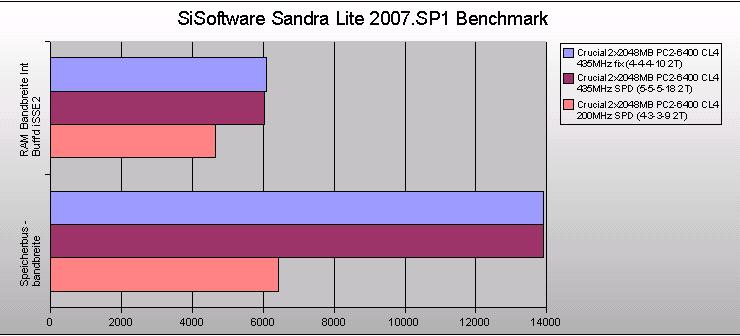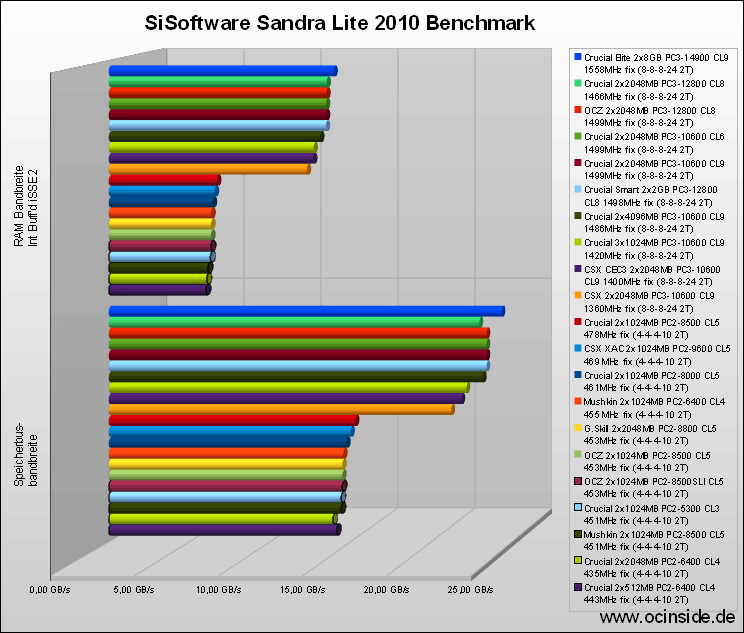
Let us continue with the most important part of the test report, because the optics and packing is of course rather secondary and the highest possible stable performance is the most important factor. CPU on different frequencies depending on the reference clock for the different memory benchmarks. Furthermore the memory modules were tested on another reference board to test the high frequency and higher voltages. The Foxconn C51XEM2AA motherboard comes with the nVidia nForce 590 SLI chipset and supports the EPP feature to realize an automatically adjustment of the memory timings. The multiplier adjustment remains on 9x with all frequencies, because an adjustment for the CPU in half multiplier steps would be too inaccurate to get nearly the same CPU frequency for all tests. Microsoft Windows XP Professional SP2 is used as the operating system. The stability was examined with the software Memtest86
and SiSoft Sandra Lite 2007.SP1 program is used for all benchmarks, since it offers extensive adjustments and a fast result comparison. BTW. the latest SiSoft Sandra 2008 version is available on our download server and can be downloaded much faster. All benchmarks are also included in the free Lite version.
But let us now continue with the review … First the maximum possible frequency of the memory module was determined. The memory frequency was increased in small steps with a fixed memory timing of 4-4-4-10 2T and default memory voltage, as long as the detailed memory test with Memtest86 runs without any errors. This quite long testing time ensured that this frequency works really stable with these modules.
The highest possible frequency with 4-4-4-10 (Tcl Trcd Tras Trp) timings was stable with 435 MHz !
Of course it’s possible to run much higher frequencies with increased voltages or lower timings, because the frequency values and timings depends directly from each other. Officially Crucial specify the voltage of 2.20 Volt without loosing the warranty. But to compare all memory modules, the default DDR2 memory voltage of 1.80 Volt is used and this results in nice 435 MHz. Thanks to CAS-4 there’s enough scope on CL5 for much higher frequency. A direct comparison of the frequency versus latency can be found in the interactive memory product ID guide.
This highest possible frequency was compared with two settings. On the one hand 435 MHz with SPD values (these are programmed in the SPD IC by the manufacturer), and on the other hand 200 MHz (x2) with SPD values.
By the way, the “Memory Bus Range” is no benchmark value, but this value is quite simple to calculate by the frequency and this is useful for a benchmark comparison.
Here’re the benchmark results:
| Frequency | Timing | RAM Range Int Buff’d iSSE2 | Memory bus range |
| 435 MHz | fix (4-4-4-10 2T) | 6083 MB/s | 13920 MB/s |
| 435 MHz | SPD (5-5-5-18 2T) | 6024 MB/s | 13920 MB/s |
| 200 MHz | SPD (4-3-3-9 2T) | 4643 MB/s | 6432 MB/s |
Here’s a diagram of the benchmark values:

Here is a direct benchmark result comparison of some DDR2 and DDR memory modules:

The Crucial Ballistix Tracer Red PC2-6400 memory modules are despite the DDR2-800 speed indication – thanks to CL4 – in a good midrange of all modules and that is very positive for such module size of each 2 GB. Starting with 1.8 Vmem (memory voltage) it’s possible to get good overclocking values, which can be improved of course with higher voltages.

